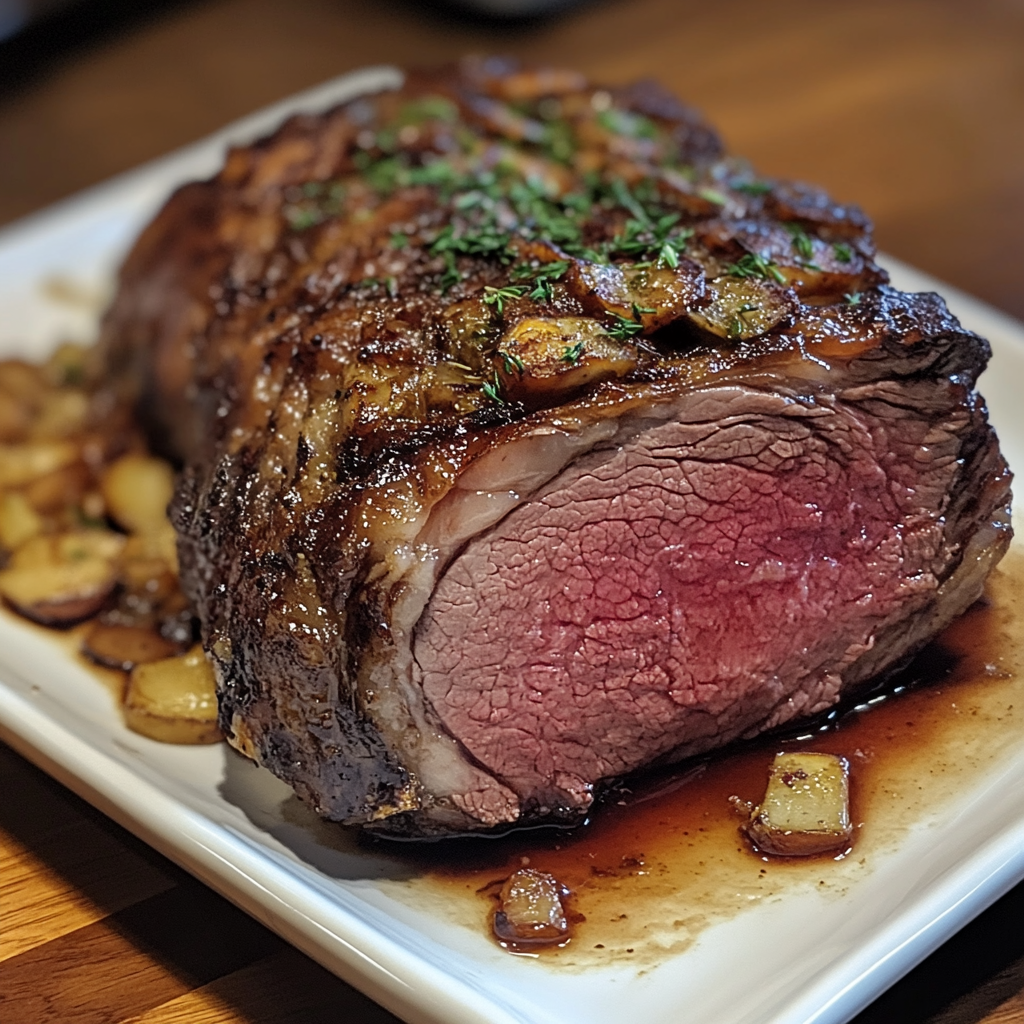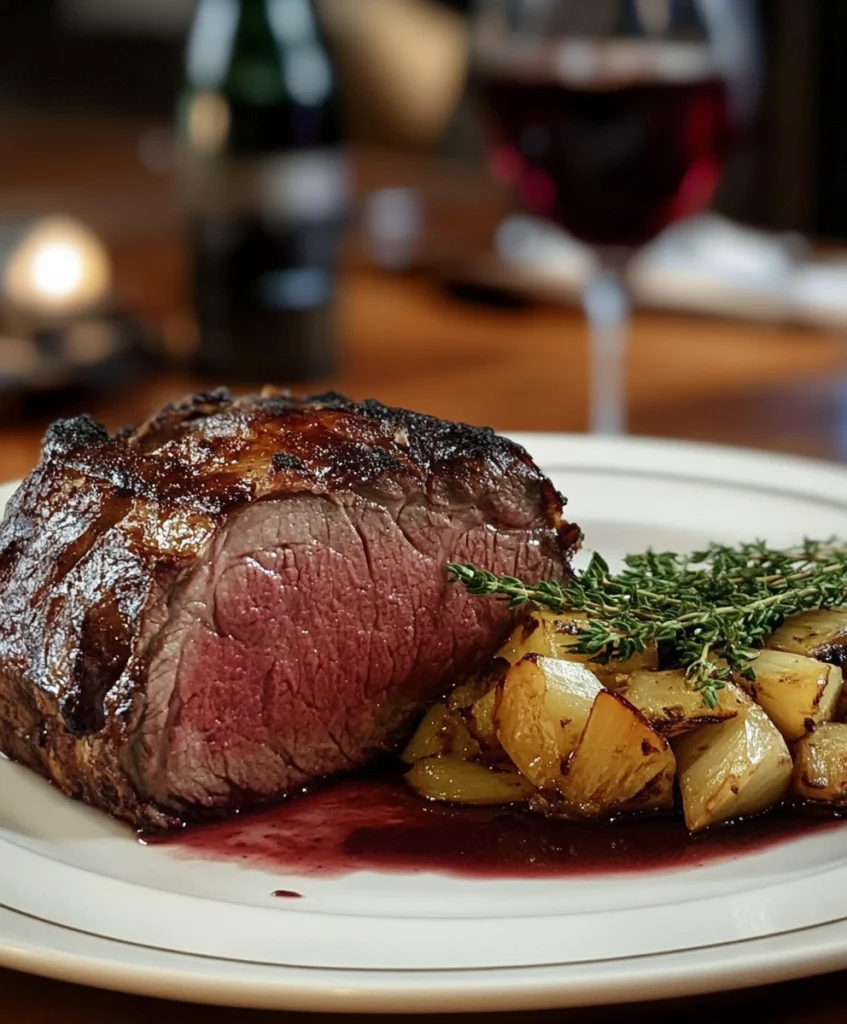I’ll never forget the Christmas that changed my holiday cooking forever. Five years ago, I was hosting my entire extended family for the first time. I had grand visions of serving a gorgeous prime rib as the centerpiece—until I saw the price tag. At nearly $20 per pound, my dream dinner quickly turned into a financial nightmare.
In a panic, I called my grandfather, a former butcher with decades of meat wisdom. His chuckle on the other end of the line was reassuring. “You don’t need prime rib to impress anyone,” he said. “I’ve got something better—something we used to call ‘Poor Man’s Prime Rib.’ Get yourself a good eye of round roast instead.”
I was skeptical. Eye of round? That lean, often tough cut that sells for a fraction of prime rib’s price? But Grandpa had never steered me wrong when it came to meat. So, I followed his instructions meticulously—and the result was nothing short of miraculous. The roast was juicy, flavorful, and so tender you could cut it with the side of a fork. My family raved, several guests asked for the recipe, and no one—not one person—suspected they weren’t eating expensive prime rib.

Since that Christmas revelation, Poor Man’s Prime Rib has become my signature dish. I’ve perfected the technique, added my own touches, and saved literally thousands of dollars over the years. Here’s how you can do the same.
Table of Contents
What Makes Poor Man’s Prime Rib Special?
The magic of this recipe lies in its preparation method. By using a reverse-sear technique, careful seasoning, and precise temperature control, you transform an inexpensive cut into something that rivals its pricey counterpart. The eye of round roast costs about $5-7 per pound (sometimes even less when on sale), compared to $17-25 for prime rib.
But it’s not just about saving money—it’s about the satisfaction of creating something exceptional from humble ingredients. There’s something deeply rewarding about that alchemy.
Ingredients
- 3-4 pound eye of round roast
- 2 tablespoons olive oil
- 4 cloves garlic, minced
- 2 tablespoons kosher salt
- 2 teaspoons freshly ground black pepper
- 1 tablespoon fresh rosemary, finely chopped
- 1 tablespoon fresh thyme leaves
- 2 teaspoons Worcestershire sauce
- 1 teaspoon mustard powder
- 1/2 teaspoon baking soda (trust me on this one!)
How to Make It
- Prep the roast: The day before cooking, pat the eye of round completely dry with paper towels. This is crucial—moisture is the enemy of a good sear.
- Create the rub: Mix the salt, pepper, herbs, garlic, mustard powder, and baking soda in a small bowl. The baking soda is my secret weapon—it helps break down the proteins in the meat for added tenderness.
- Season generously: Brush the roast with olive oil, then rub the Worcestershire sauce all over. Apply the seasoning mixture liberally to all sides, pressing it in to adhere.
- Dry age (sort of): Place the seasoned roast on a wire rack set over a baking sheet. Leave it uncovered in your refrigerator overnight or up to 24 hours. This creates a dry exterior and allows the seasonings to penetrate deeply.
- Bring to room temperature: Two hours before cooking, remove the roast from the refrigerator and let it come to room temperature. This ensures even cooking.
- Low and slow first: Preheat your oven to 225°F. Place the roast on a rack in a roasting pan and insert a meat thermometer. Cook slowly until the internal temperature reaches 125°F for medium-rare (about 1.5 hours, but time varies based on size).
- Rest: Remove the roast from the oven and tent loosely with foil. Let it rest for 20-30 minutes while you increase the oven temperature to 500°F.
- The final sear: Return the roast to the very hot oven for 8-10 minutes to create a beautiful brown crust. Watch carefully to prevent burning.
- Final rest: Allow the roast to rest for another 10 minutes before slicing very thinly against the grain.
Serving Suggestions
For the full prime rib experience, I serve my Poor Man’s Prime Rib with homemade horseradish cream sauce (just mix prepared horseradish with sour cream, a touch of mayonnaise, lemon juice, and salt).

Traditional accompaniments like Yorkshire pudding, roasted potatoes, and a green vegetable complete the plate. I always include a rich beef jus, made by deglazing the roasting pan with beef broth and red wine, then reducing until slightly thickened.
The presentation is just as important as the preparation. Slice the meat very thinly—think deli-meat thin—and arrange it slightly overlapping on warmed plates. This is crucial because while your roast will be tender, it doesn’t have the same fat marbling as true prime rib, so thin slicing ensures every bite remains tender.
My Honest Opinion
After years of serving both the real thing and my budget version, I’ve come to a somewhat controversial conclusion: I sometimes prefer Poor Man’s Prime Rib. Yes, it lacks the extreme marbling and richness of prime rib, but that can sometimes be overwhelming. What my version offers is pure beef flavor, an incredible crust, perfect doneness from edge to edge, and the satisfaction of knowing I haven’t blown my entire food budget on a single meal.
Is it exactly the same as prime rib? No, and no one with a trained palate would be truly fooled. But is it a delicious, impressive main course that delivers 90% of the prime rib experience at 30% of the cost? Absolutely.
The greatest compliment came last year when my grandfather—the very one who taught me this technique—asked if I’d “splurged on the real thing this time.” When I told him it was still his Poor Man’s version, his smile was worth more than all the prime rib in the world.
So this holiday season, give your wallet a break and your family a treat. Poor Man’s Prime Rib might just become your tradition too.
You may also like Delicious Baked Ziti Recipe No Meat.

Amazing Poor Man’s Prime Rib: Luxury Taste on a Budget
Equipment
- Roasting pan with rack
- Meat thermometer
- Mixing bowl
- Wire rack
- Aluminum foil
Ingredients
For the Roast
- 3-4 lbs eye of round roast
- 2 tbsp olive oil
- 4 cloves garlic minced
- 2 tbsp kosher salt
- 2 tsp black pepper freshly ground
- 1 tbsp fresh rosemary finely chopped
- 1 tbsp fresh thyme leaves
- 2 tsp Worcestershire sauce
- 1 tsp mustard powder
- ½ tsp baking soda helps tenderize meat
Instructions
- Pat the eye of round roast completely dry with paper towels. Moisture prevents a good sear, so this step is crucial.
- In a small bowl, mix together salt, pepper, rosemary, thyme, garlic, mustard powder, and baking soda.
- Brush the roast with olive oil and Worcestershire sauce. Generously rub the seasoning mixture over the entire roast, pressing it in to adhere.
- Place the seasoned roast on a wire rack set over a baking sheet. Refrigerate uncovered for at least 12 hours, up to 24 hours, for better flavor and texture.
- Two hours before cooking, remove the roast from the refrigerator and let it come to room temperature for even cooking.
- Preheat the oven to 225°F (107°C). Place the roast on a rack in a roasting pan and insert a meat thermometer into the thickest part.
- Roast slowly until the internal temperature reaches 125°F (52°C) for medium-rare. This takes about 1.5 hours, but monitor closely.
- Remove the roast from the oven, tent loosely with foil, and let it rest for 20-30 minutes. Meanwhile, increase oven temperature to 500°F (260°C).
- Place the roast back into the hot oven for 8-10 minutes to develop a rich brown crust. Watch carefully to prevent burning.
- Remove from oven and let rest for another 10 minutes. Slice very thinly against the grain for the best texture.
